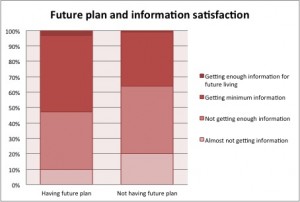Ideas of Employees at Sanriku Railway limit losses
Large sections of the Kita Riasu and Minami Riasu train lines on the Pacific Coast of Iwate Prefecture were badly damaged by the tsunami on March 11 last year. Following the re-opening of the Kita Riasu line between Tanohota and Rikuchunoda stations in April this year, some 61 of 107 kilometers of track is now back in use, and both lines are scheduled to be back in full operation by April 2014. More than 10 billion yen will be needed to restore the lines operated by the Sanriku Railway Company. The central government will bear some of these costs but issues remain.

The Iwate Prefectural government owns 48 percent of the stock in Sanriku Railway and another 19.3 percent is owned by local governments through which the train lines pass. Sanriku Railway was the first “third sector” railway company in Japan, in which both the public and private sector hold a stake. While it has a duty to provide public transportation that is safe and reliable, as a company with shares it also must focus on profit. It needs to restore the lines promptly for its medium and long term future but it also needs to focus on operations for the current financial year. Train fares form the base of revenue and after the tsunami they were naturally forecast to fall. Sanriku Railway President Masahiko Mochizuki predicted a decrease of 150 million yen in annual revenue.

Limited edition pieces of the damaged rail. A 10cm section cost 50,000 yen and a 5cm section cost 30,000 yen. Over 100 pieces of each sold on the first day.
In the year following the Great East Japan Earthquake passenger numbers dropped from 850,000 to less than 300,000, and fare revenue fell by some 220 million yen. This figure was more than the president’s forecast but the overall net loss was not as severe due to increases in revenue from new sources and a fall in operating costs. 14 million yen was earned in the sale of train tickets ordered by people all over Japan, 15 million yen from purchases of original goods, 24 million yen from sales of individual pieces of the rail damaged by the tsunami, and 10 million yen from training for company employees and public servants carried out in affected areas. Operating costs also fell by 100 million yen and the net loss for the year was limited to 20 million yen.

Popular “Akaji Sembei” rice crackers on sale. Akaji means to be in the red or making a loss.
The better than expected result is largely due to the efforts of its employees who came up with the ideas. President Mochizuki says that he asks each of the employees to make sure they earn their living and plays down their achievements, but the high level of involvement of each of the employees and the nature of the company to enable this led to the result. There is a feeling within the company that it functions together as one. Mochizuki is concerned however that the new revenue streams are not sustainable and he doesn’t expect them to continue in the long term. He looks five or ten years down the track and considers how the company will re-build its core business of transportation, and what role the local lines should play in the community.
(Translated by Nate Hill)
Tweet




